Author | Ban Jiang
Smart Chassis Series (1) | Overview: The Yesterday, Today, and Tomorrow of Smart Chassis
Smart Chassis Technology (2) | Development Overview of Automotive Brake Systems
Smart Chassis Technology (3) | Starting with Vacuum Booster
In the previous article, the basic components and working principle of the vacuum booster were introduced. The prerequisite for the vacuum booster to work is to generate a stable vacuum source based on the engine. With the popularity of new energy vehicles, especially pure electric vehicles, replacing the engine with an electric motor has limited the use of vacuum boosters. Against this backdrop, as a globally leading company in chassis line control technology, Bosch of Germany has launched the iBooster, a hydraulic line control brake booster product with intelligence after in-depth research and development.
After Bosch, new intelligent booster manufacturers have emerged in the domestic and foreign markets, with mainstream companies such as Continental, ZF, China’s Nasen and Inovance Intelligent, etc. Each manufacturer has a different name, but they are collectively referred to as eBooster in the industry.
eBooster provides new solutions for vehicle manufacturers, not depending on a vacuum source, and replacing traditional vacuum pumps and vacuum hoses, with a smaller size and lighter weight for the entire brake system, without the need to consume energy to establish a vacuum source, only consuming electricity when braking, thereby achieving energy-saving and carbon reduction goals, more in line with future development trends. Therefore, it has been favored by mid-to-high-end models, and its market share has been increasing.
This article will introduce the basic functions and working principle of eBooster.
Basic Brake Functions of eBooster
eBooster uses sensors to sense the force and speed of the driver stepping on the brake pedal, and after processing the signal, it is transmitted to the electronic control unit. The electronic control unit controls the assist motor to generate corresponding torque. Under the drive of the electromechanical amplification mechanism, the piston moves and hydraulic pressure is applied to the wheel cylinder to achieve wheel-end braking. Compared with the vacuum booster, the electronic control unit of eBooster can achieve faster brake response speed and more precise brake force control.
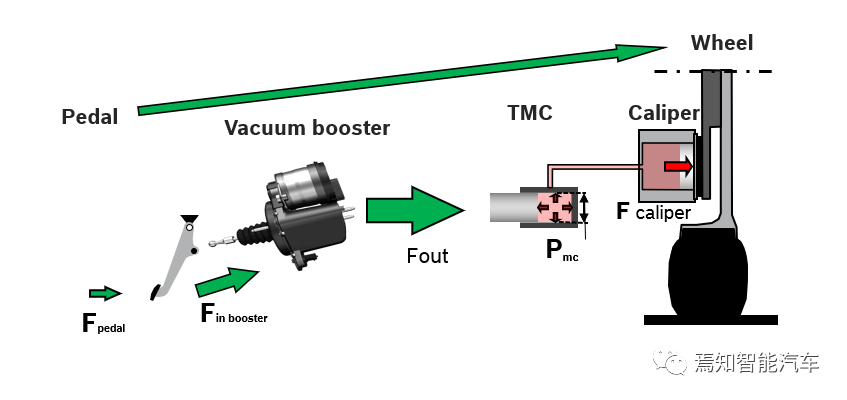 Taking Bosch’s iBooster product as an example, the travel displacement sensor of the iBooster identifies the driver’s braking intention by detecting the relative position changes between the pedal pushrod and the iBooster chamber. The power unit consists mainly of an assist motor and a two-stage reducer. To achieve lightweight design, all transmission gears except for the actively driven small gears are made of non-metallic materials. This also puts higher requirements on the durability of non-metallic materials.
Taking Bosch’s iBooster product as an example, the travel displacement sensor of the iBooster identifies the driver’s braking intention by detecting the relative position changes between the pedal pushrod and the iBooster chamber. The power unit consists mainly of an assist motor and a two-stage reducer. To achieve lightweight design, all transmission gears except for the actively driven small gears are made of non-metallic materials. This also puts higher requirements on the durability of non-metallic materials.
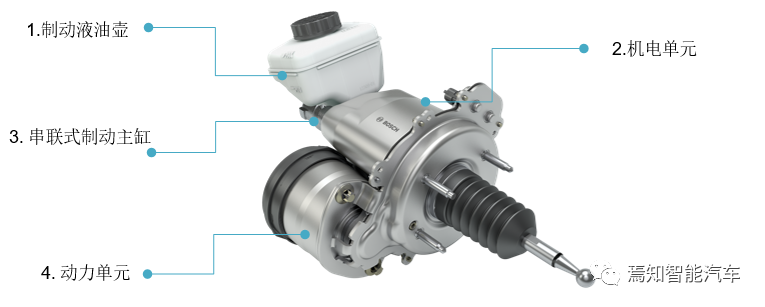
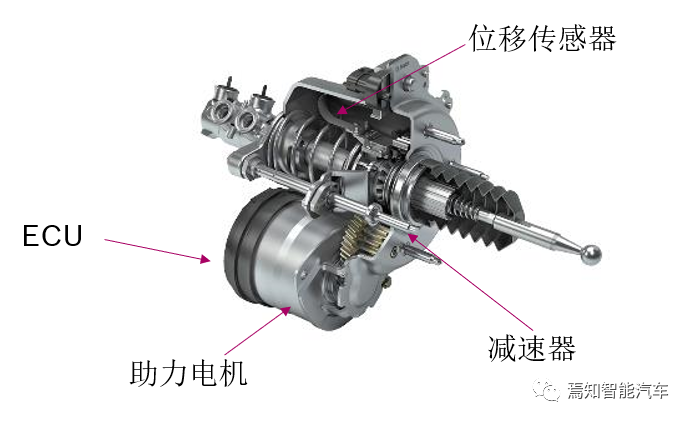
Furthermore, eBooster is a non-decoupled pedal system, just like a vacuum booster. During the braking process, eBooster can provide the most authentic and natural pedal feel. The driver can intuitively feel the changes in the braking system, such as ABS feedback force and brake lining degradation. The driver can discover potential problems in the braking system in a timely manner and take appropriate actions to reduce safety hazards.
To meet the diversity and comfort of driver’s feeling, eBooster can also adjust the pedal feel through software to switch between comfortable and sporty driving styles.

eBooster degradation strategy
According to regulations, the comfort braking system of passenger cars needs to provide a deceleration of no less than 6.43m/s² when the driver applies a braking force of 500N. According to mandatory regulations, even in the event of electronic power failure, the mechanical components of passenger cars must still ensure that the driver can produce a deceleration of 2.44 m/s² when applying 500Nm of brake pedal force.
Vehicles equipped with eBooster will also be equipped with the Electronic Stability Control (ESC) system. With the assistance of the ESC system, eBooster not only meets regulatory requirements but also demonstrates higher availability than traditional vacuum boosters.
ESC and eBooster share a hydraulic system on the vehicle, and their coordinated work principle is as follows:
- eBooster and ESC share a brake oil tank, brake master cylinder, and brake piping system.- The booster motor in eBooster generates driving force to push the main cylinder piston and make the brake fluid in the oil pot flow into the main cylinder pipeline and enter the ESC inlet valve. It then flows into the four wheel cylinders through the pressure regulating valve and the inlet valve in ESC, thus establishing braking force.
- When eBooster is not working, ESC can also independently control the brake fluid to flow from the main cylinder into the wheel cylinders, thus establishing braking force.
- eBooster has a faster dynamic response speed to build pressure than ESC, and its NVH performance is better. Therefore, eBooster is the main actuator in the brake control system.
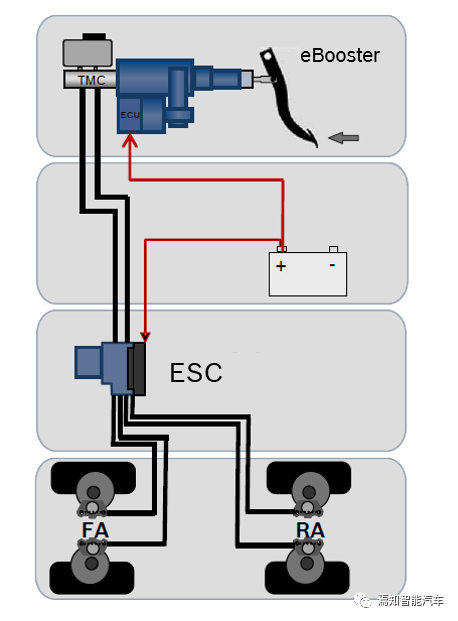
As shown in the figure below, in full function mode, eBooster efficiently and accurately assists the driver’s braking through the control of the power-assist unit. When eBooster fails and the power assist system is disabled, eBooster requests ESC to activate the HBC (Hydraulic Brake Failure Compensation) function. After the HBC function is activated, when the driver presses the brake pedal, the master cylinder pressure changes, and the HBC function identifies the driver’s braking intention according to the change in master cylinder pressure, and controls the working of the pressure pump to actively establish wheel cylinder pressure, thereby assisting the driver. In the event that both eBooster and ESC fail (such as a total vehicle power failure), when the driver presses the brake pedal, the pedal force directly acts on the push rod. The push rod pushes the main cylinder piston to move, causing the hydraulic pressure in the master cylinder to flow into the wheel cylinders, thereby generating braking force. This process is a pure mechanical pressure build-up that can produce a deceleration of 2.44m/s² under a force of 500Nm.
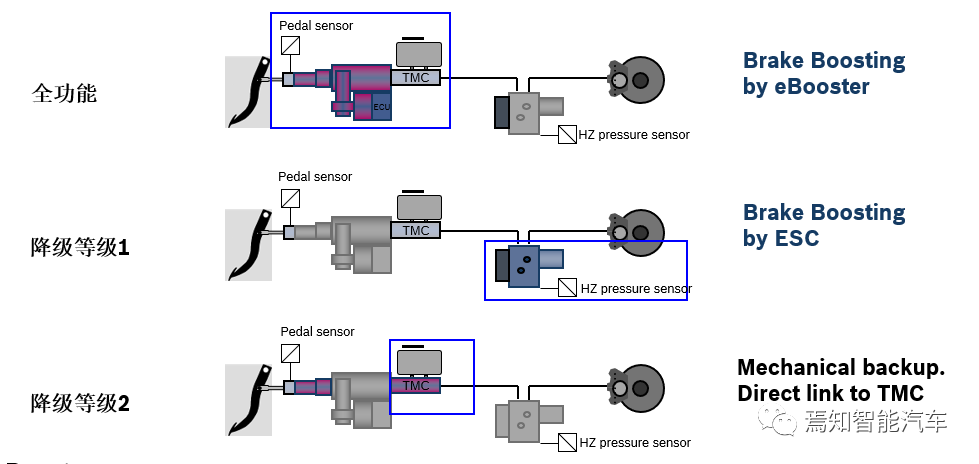
eBooster realizes better brake energy recovery function
From the perspective of energy conversion, in traditional cars, the brake caliper tightens the brake disc under the push of hydraulic pressure in the wheel cylinder during braking, and the kinetic energy of the entire vehicle is dissipated through friction between the brake disc and the brake pad. During this process, the kinetic energy is not effectively utilized.
The brake energy recovery function has been developed in parallel with the popularity of new energy vehicles. With the function of brake energy recovery, in addition to friction braking produced by hydraulic pressure, the high-voltage battery and the drive motor collaborate to produce negative torque to provide part of the braking force, and negative torque produces reverse current to charge the high-voltage battery. Finally, part of the vehicle’s kinetic energy during braking is converted into chemical energy and stored in the high-voltage battery for the next vehicle drive, thus achieving energy recovery and reducing energy consumption and emissions.In traditional energy recovery brake control, when the driver releases the pedal, the motor generates a small braking torque to produce a deceleration of 0.1 to 0.2g. When the driver presses the brake pedal, the motor braking force continues and increases moderately, while the hydraulic braking force also increases with the depth of the pedal, and the two braking forces add up to achieve vehicle braking. Although this simple braking force addition achieves energy recovery, it also brings new problems: compared to fuel vehicles, the driver will feel the changes in the brake pedal feel, so driving a new energy vehicle requires adaptation.
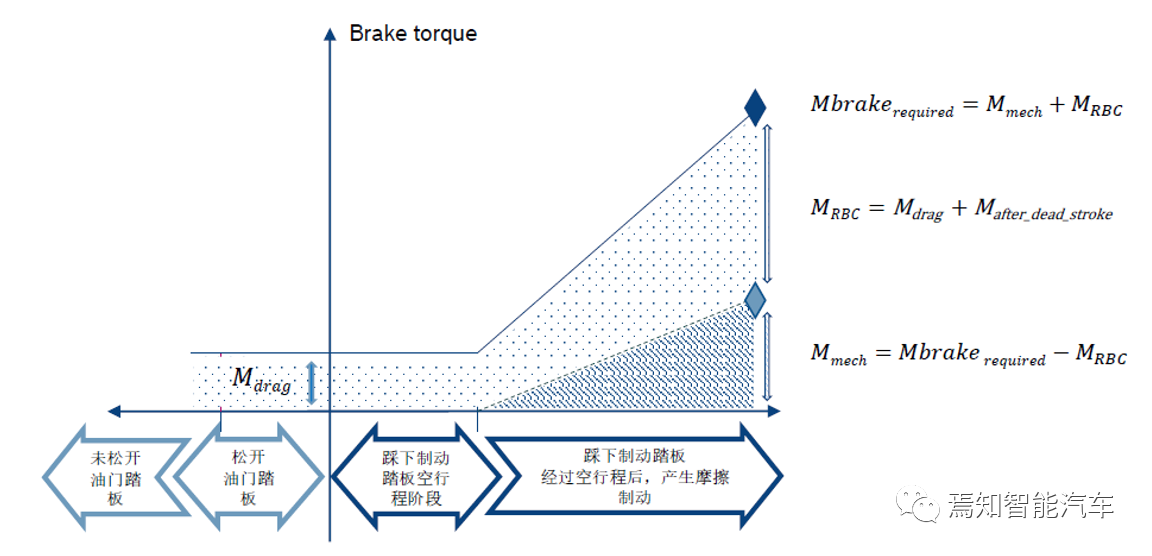
The combination of eBooster and ESC can perfectly solve the problem of inconsistent pedal feel on fuel vehicles and new energy vehicles, which requires appropriate design optimization of the hardware of ESC – increasing the capacity of the ESC accumulator. With the support of a large-capacity accumulator, when the driver presses the brake pedal, the eBooster controls the hydraulic master cylinder to enter the wheel cylinder to generate braking force, while the motor braking force slowly increases as the brake pedal depth increases. During this process, some of the brake fluid from the master cylinder is temporarily stored in the accumulator, and the brake fluid in the accumulator doesn’t produce braking force. The amount of fluid in the accumulator and the motor braking force can be coordinated and controlled, thus offsetting each other, and during this process, eBooster always ensures a constant pedal reaction force under the same pedal depth by controlling the boost size, as shown in the figure below, making the driver unable to feel whether it is motor braking or hydraulic fluid braking, thereby achieving consistency in pedal feel and bringing the most comfortable experience to the driver.

This article is a translation by ChatGPT of a Chinese report from 42HOW. If you have any questions about it, please email bd@42how.com.
